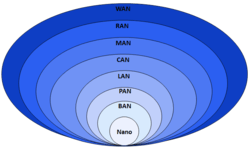Campus network
A campus network, campus area network, corporate area network or CAN is a computer network made up of an interconnection of local area networks (LANs) within a limited geographical area.[1][2] The networking equipments (switches, routers) and transmission media (optical fiber, copper plant, Cat5 cabling etc.) are almost entirely owned by the campus tenant / owner: an enterprise, university, government etc.[3] A campus area network is larger than a local area network but smaller than a metropolitan area network (MAN) or wide area network (WAN).
| Computer network types by spatial scope |
|---|
 |
University campuses
College or university campus area networks often interconnect a variety of buildings, including administrative buildings, academic buildings, university libraries, campus or student centers, residence halls, gymnasiums, and other outlying structures, like conference centers, technology centers, and training institutes.
Early examples include the Stanford University Network at Stanford University,[4] Project Athena at MIT,[5] and the Andrew Project at Carnegie Mellon University.[6]
Corporate campuses
Much like a university campus network, a corporate campus network serves to connect buildings. Examples of such are the networks at Googleplex and Microsoft's campus. Campus networks are normally interconnected with high speed Ethernet links operating over optical fiber such as gigabit Ethernet and 10 Gigabit Ethernet.
Area range
The range of CAN is 1 km to 5 km. If two buildings have the same domain and they are connected with a network, then it will be considered as CAN only. Though the CAN is mainly used for corporate campuses so the data link will be high speed.
References
- Edwards, Wade. CCNP Complete Study Guide (642-801, 642-811, 642-821, 642-831). Sybex. © 2005
- Long, Cormac. IP Network Design. McGraw-Hill/Osborne. © 2001.
- Gary A. Donahue (June 2007). Network Warrior. O'Reilly. p. 5.
- "Network (SUNet — The Stanford University Network)". Stanford University Information Technology Services. July 16, 2010. Retrieved May 4, 2011.
- "Athena history (1983 - present) from A to Z". MIT. Retrieved May 4, 2011.
- N. S. Borenstein (December 1996). "CMU's Andrew project: a retrospective". Communications of the ACM. 39 (12): 298. doi:10.1145/272682.272717.